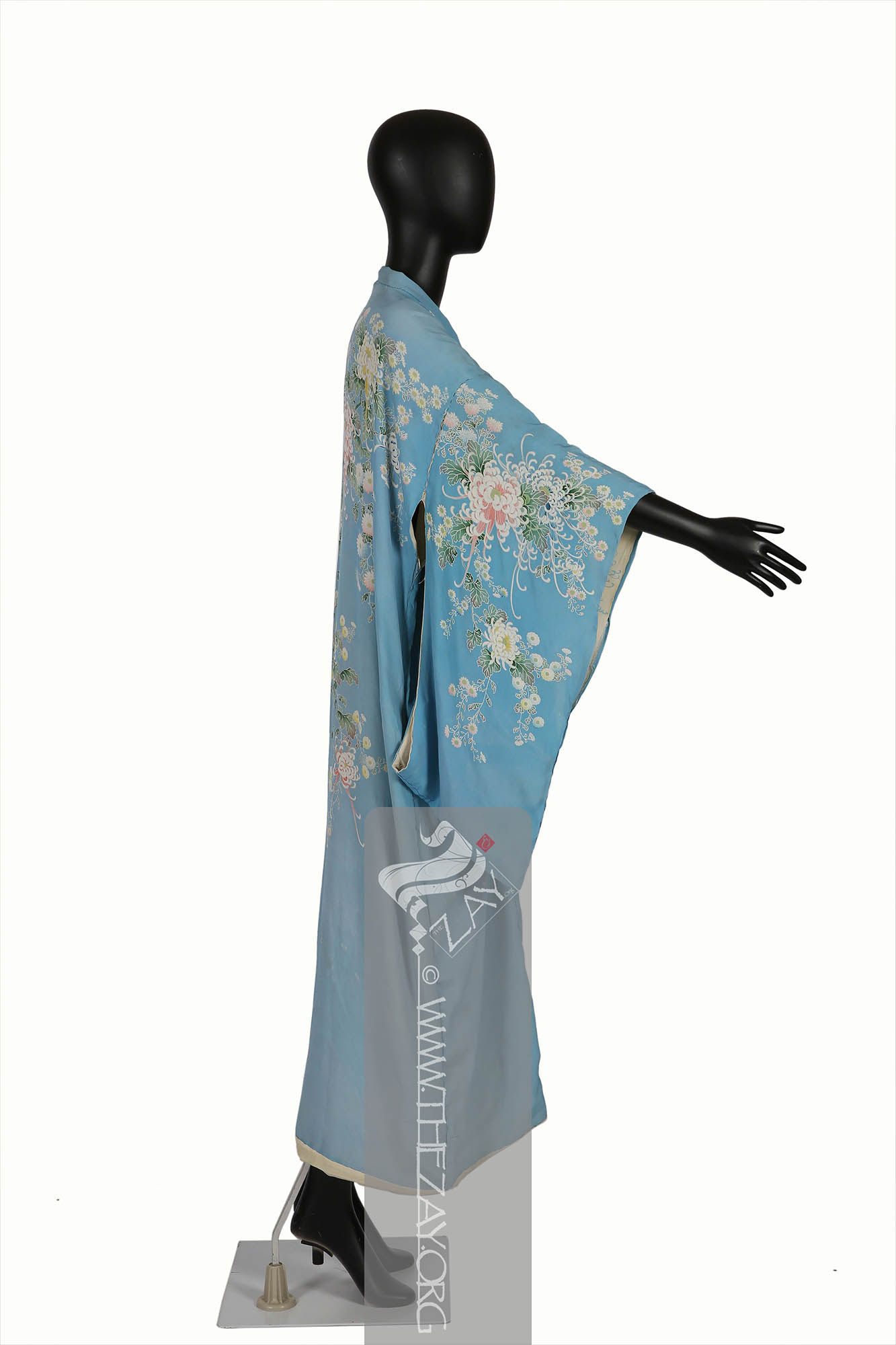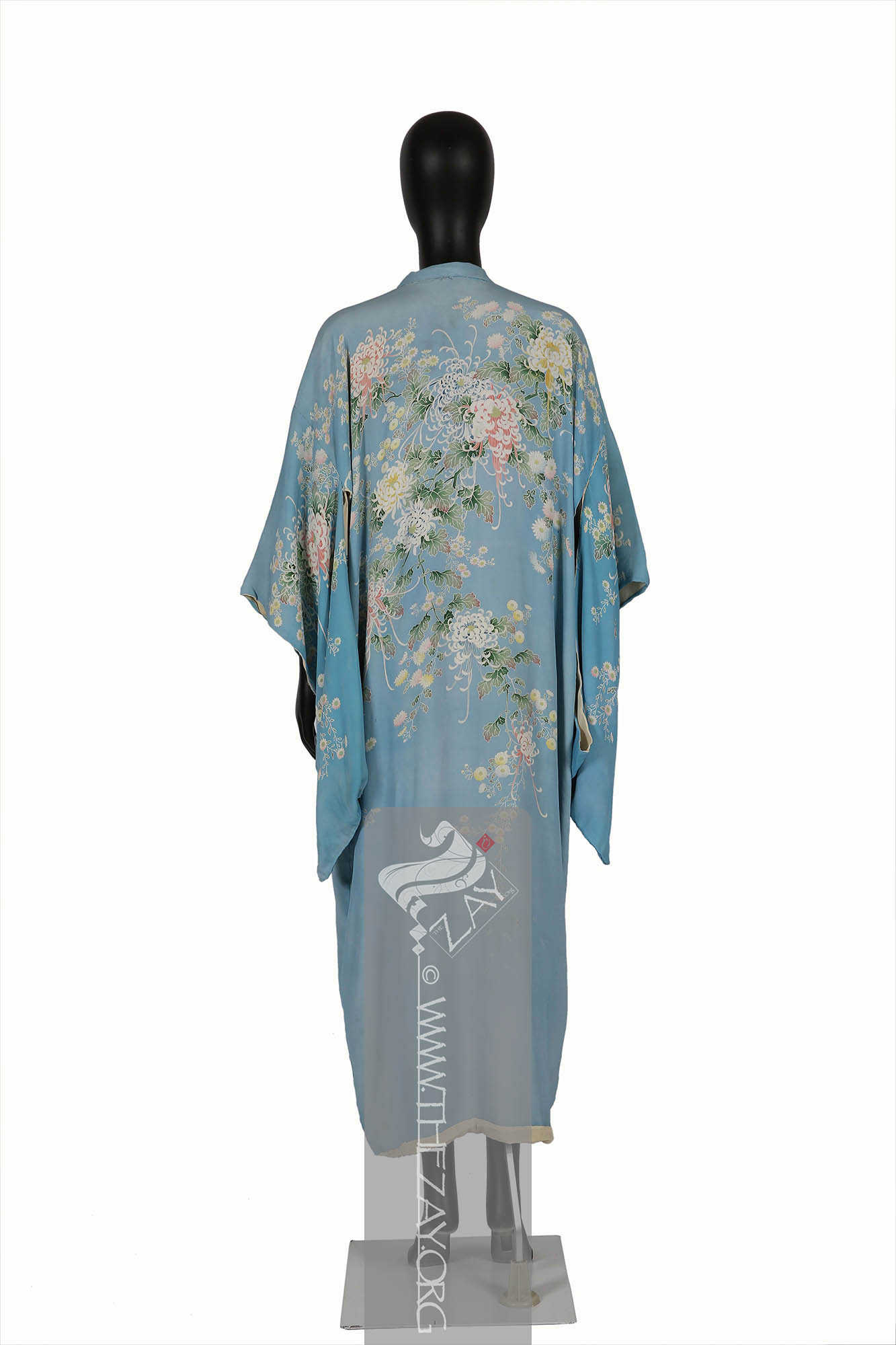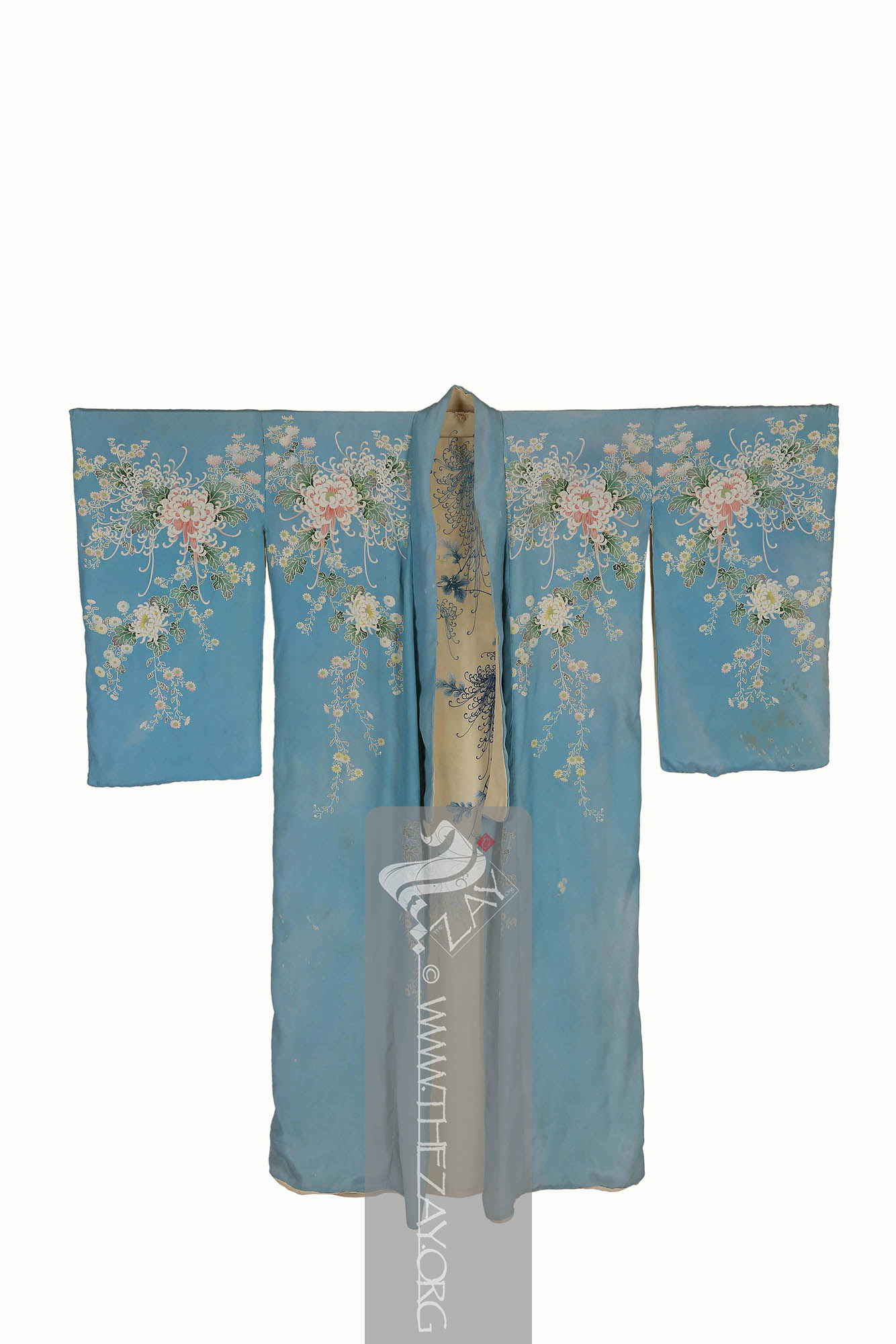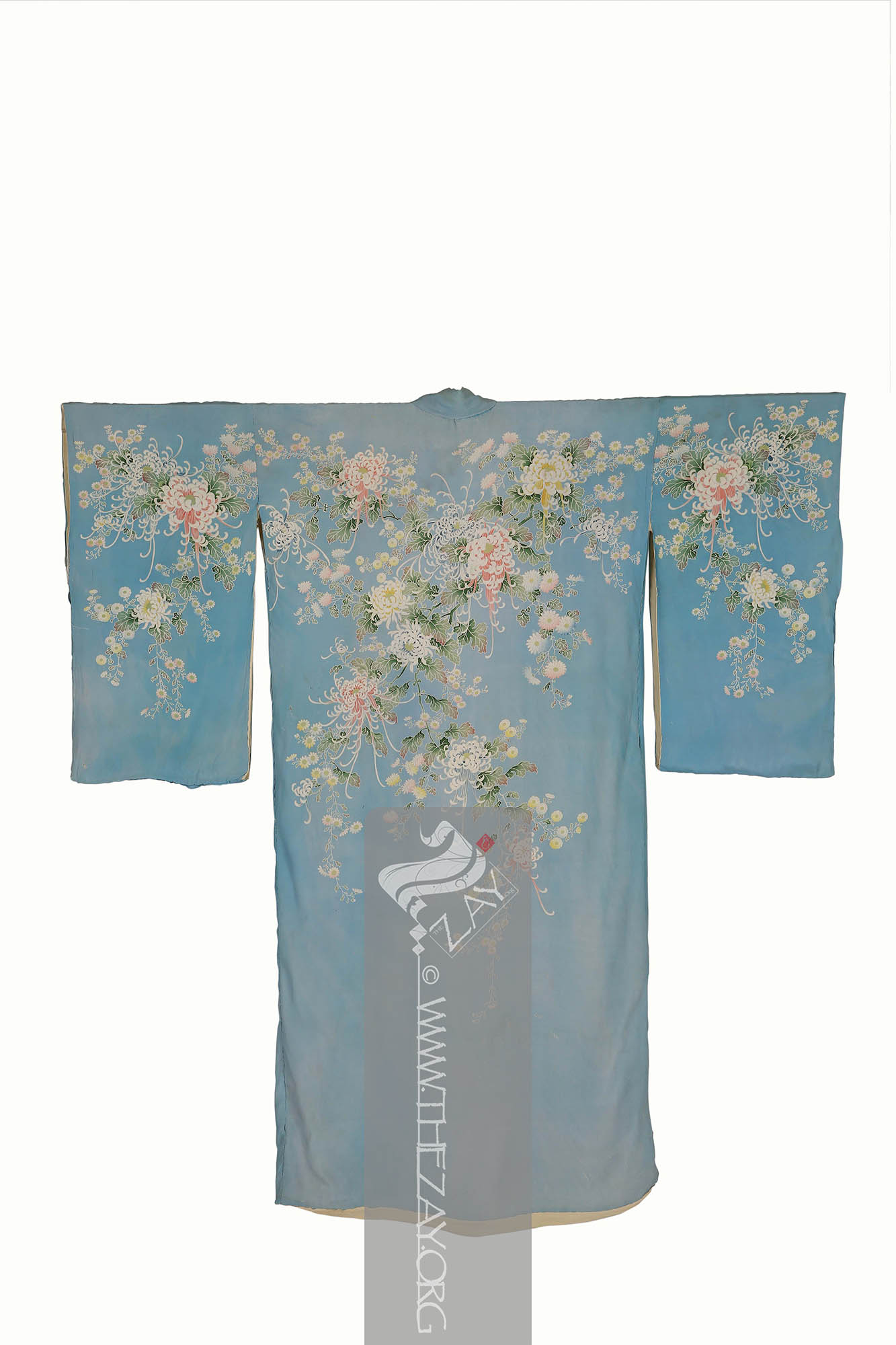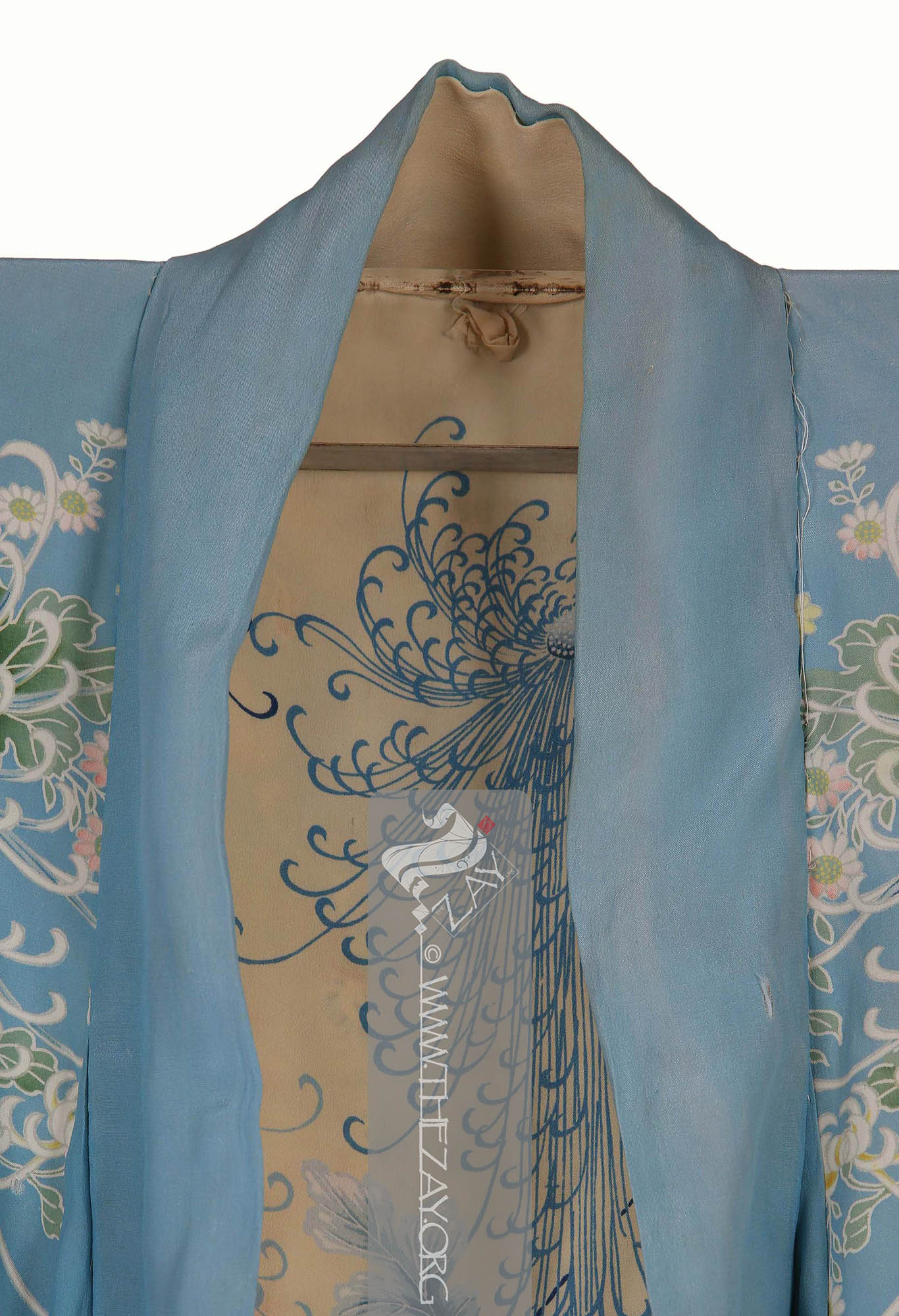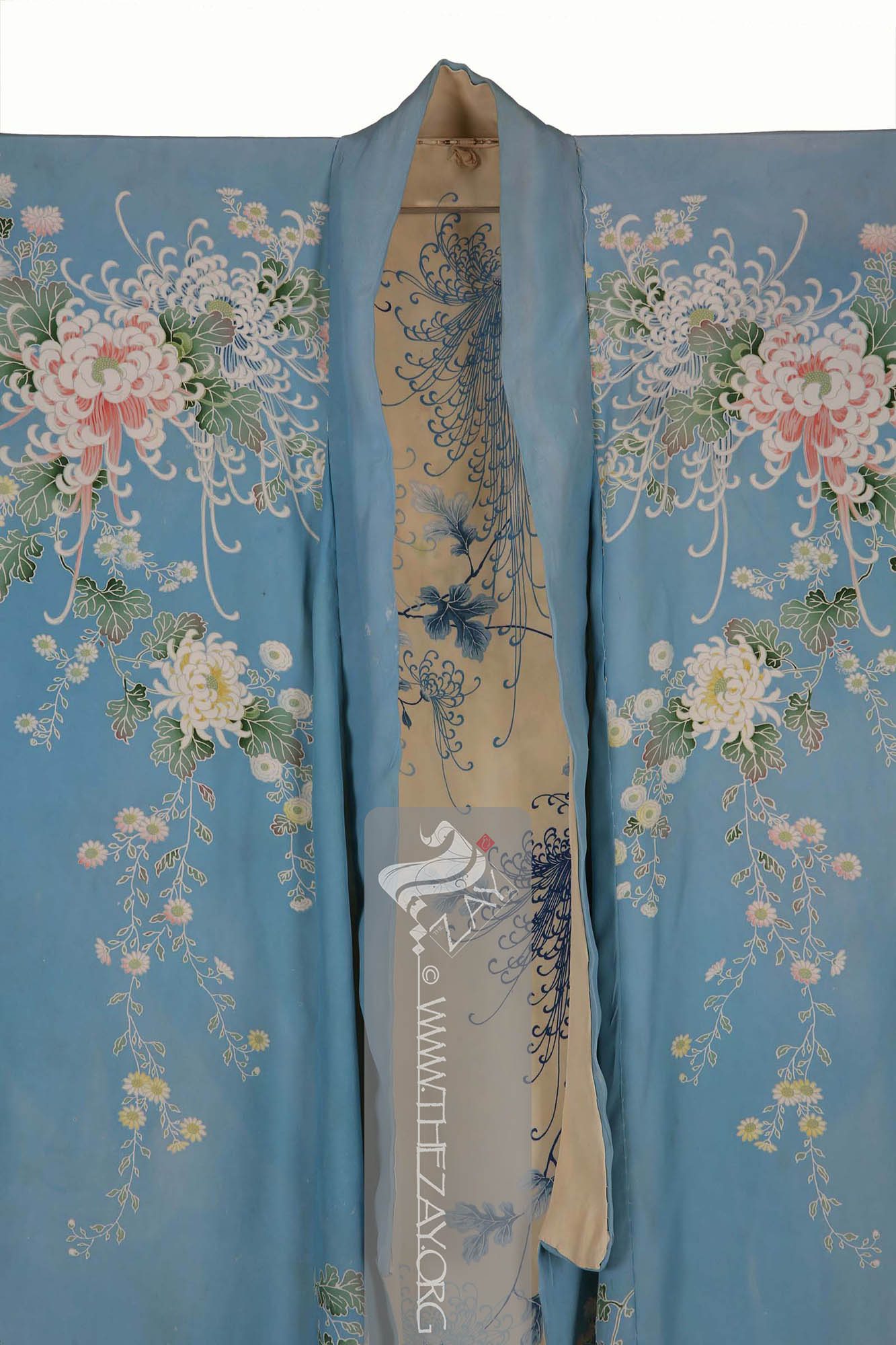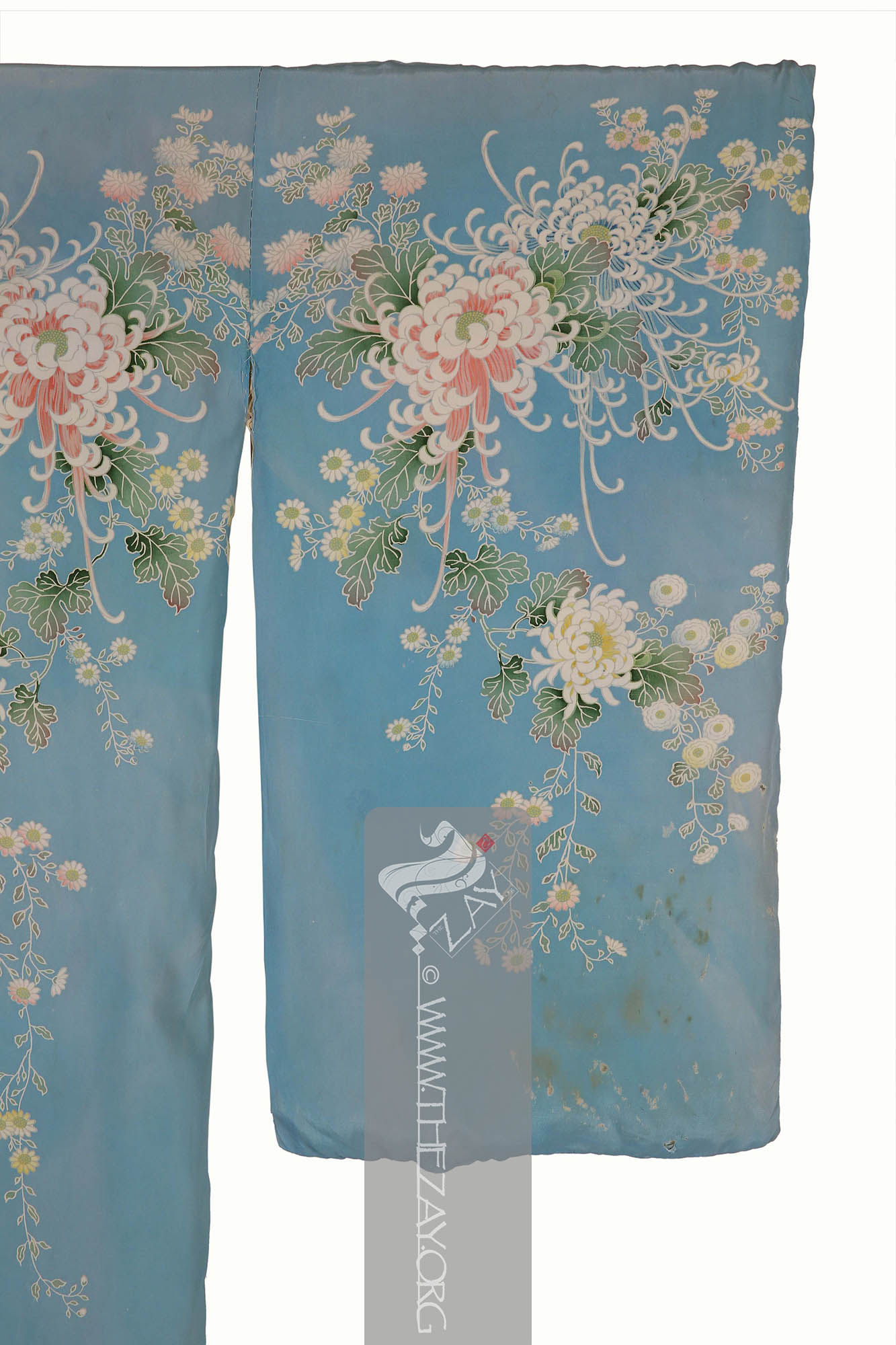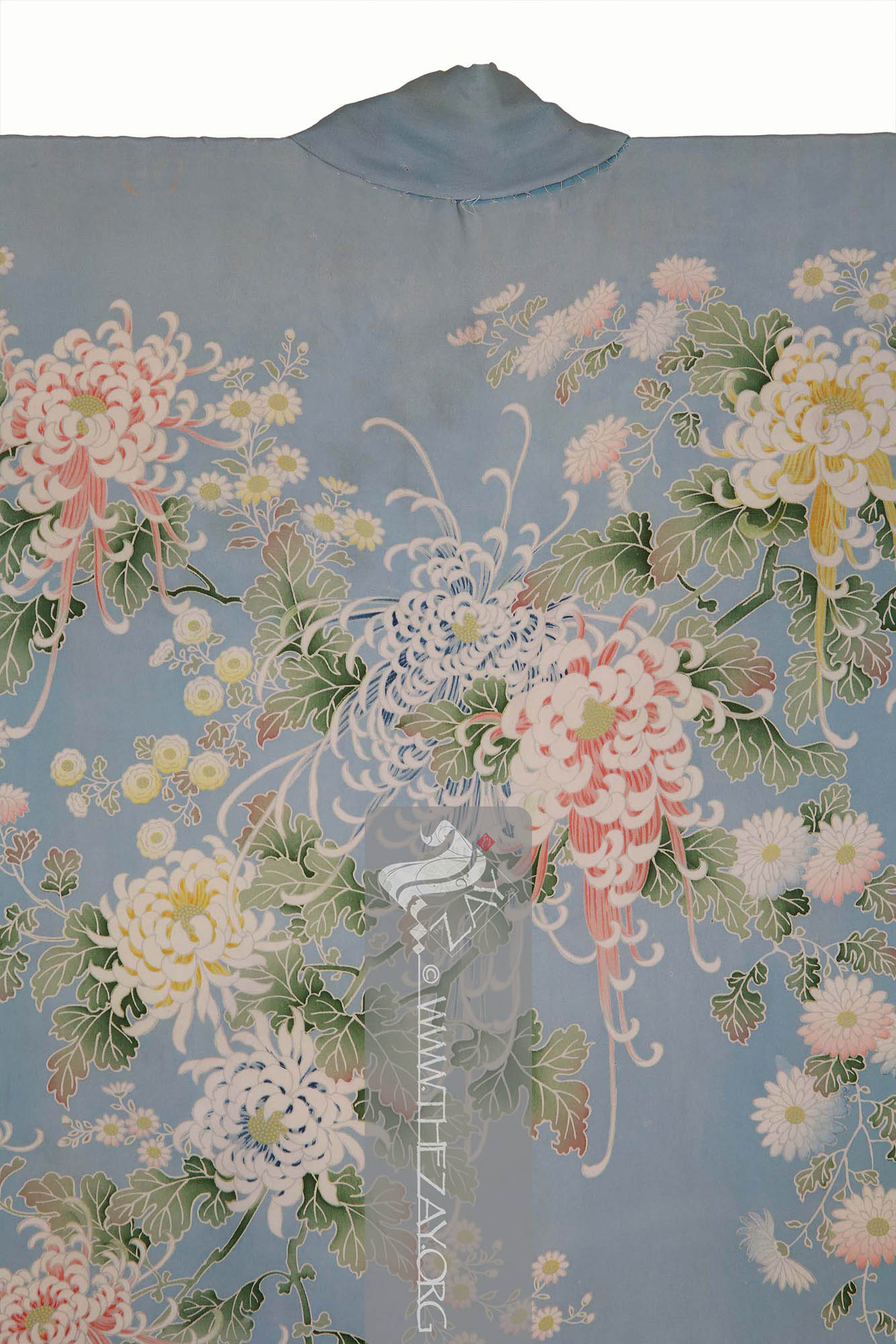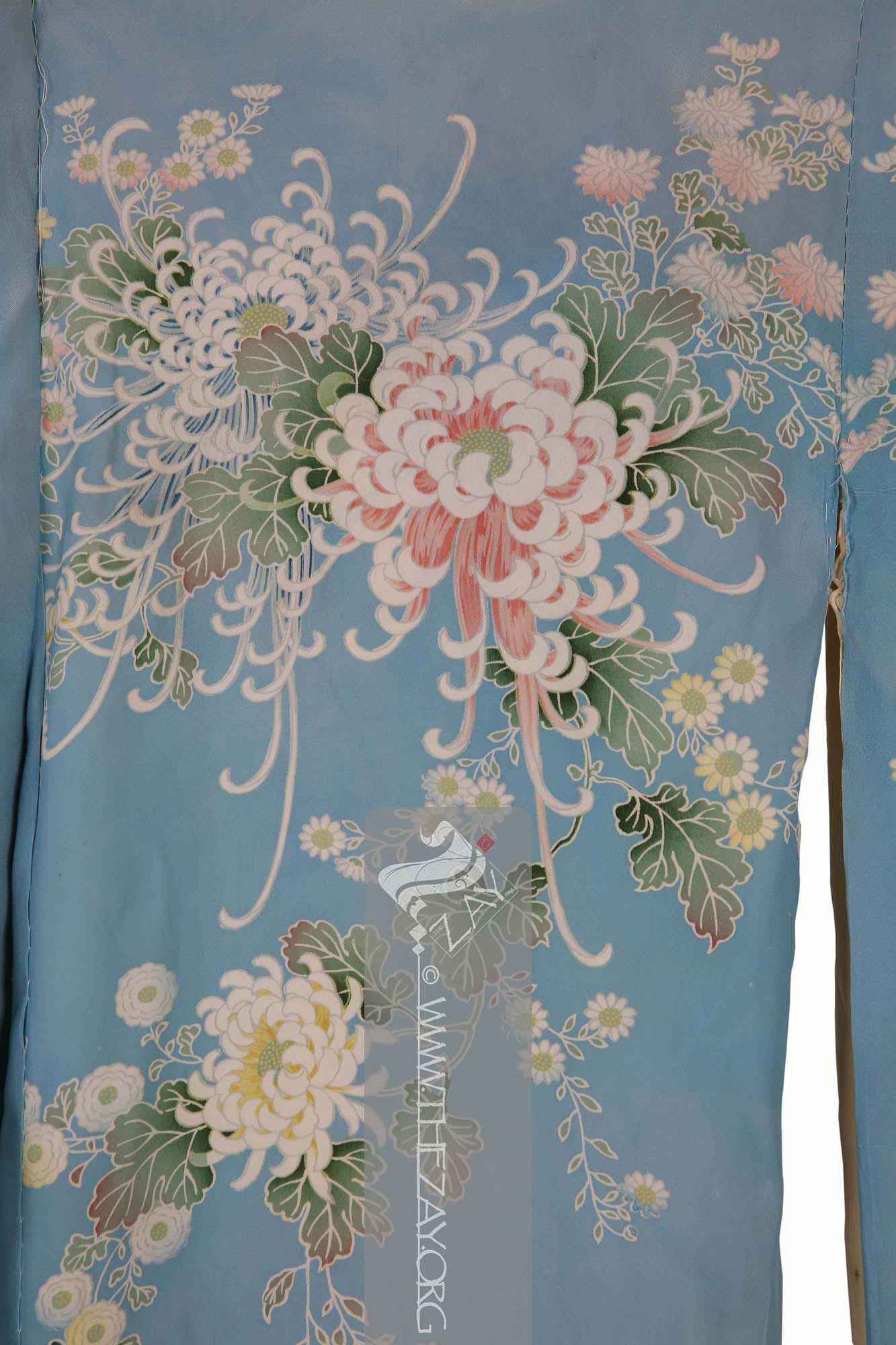Object History This elegant dress (
furisode_kimono
Furisode_kimono: (Japanese: Furisode – swinging sleeves), a type of kimono
Kimono: (Japanese: ki : wearing, mono: thing, Singular: Kimono) A traditional Japanese long loose robe with wide sleeves tied with a sash around the waist. Presently it is the national dress of Japan. characterised by its long sleeves that can reach up to the ankles. Traditionally worn by only unmarried women for formal events. It often features a vibrant design that covers the entire fabric and is typically made of silk. ) was gifted to
Dr. Reem Tariq
Ṭariq: (Arabic; Synonym: tulle_bi_talli
Tūlle_bi_tallī: (French: Tulle – a city in France where fine material for veil was first made; Turkish: tel – wire; Synonym: tariq; talli; badla; khus_dozi ), series of small metal knots made on a woven net ground as embellishment. The term is commonly used in the North African Arab region specifically in Egypt.
; talli; badla; khus_dozi ), series of small metal knots made on a woven net ground as embellishment. The term is commonly used in the Levant Arab region specifically in Lebanon.
El Mutwalli
Dr. Reem Tariq
Ṭariq: (Arabic; Synonym: tulle_bi_talli
Tūlle_bi_tallī: (French: Tulle – a city in France where fine material for veil was first made; Turkish: tel – wire; Synonym: tariq; talli; badla; khus_dozi ), series of small metal knots made on a woven net ground as embellishment. The term is commonly used in the North African Arab region specifically in Egypt.
; talli; badla; khus_dozi ), series of small metal knots made on a woven net ground as embellishment. The term is commonly used in the Levant Arab region specifically in Lebanon.
el Mutwallī: Founder (CEO) of the Zay
Zay: (Arabic: costume, Pl. azyaā’), a set of clothes in a style typical of a particular country or historical period. Initiative, a public figure, speaker and author. An expert curator and consultant in Islamic art and architecture, interior design, historic costume, and UAE heritage. from Athbah Al Kalamchi, her sister-in-law. It was originally an heirloom handed down from her grandparents and belonged possibly to the period between c.1930 - 1950.
Athbah Al Kalamchi was born 1959 in Lebanon and grew up in Iraq. She graduated with BS in economics from Baghdad university. Married to an Italian she moved to Italy in 1990 where she continues to reside with her only son Omar.
Athbah’s maternal grandfather Dhafir Rashid Al Zahawi had professional ties in China and the Far East. He constantly travelled back and forth to the Far East and this item was bought in one of his several trips there.
Object Features This is a beautiful furisode_kimono
Furisode_kimono: (Japanese: Furisode – swinging sleeves), a type of kimono
Kimono: (Japanese: ki : wearing, mono: thing, Singular: Kimono) A traditional Japanese long loose robe with wide sleeves tied with a sash around the waist. Presently it is the national dress of Japan. characterised by its long sleeves that can reach up to the ankles. Traditionally worn by only unmarried women for formal events. It often features a vibrant design that covers the entire fabric and is typically made of silk. in light blue (chirimen
chirimen: A Japanese crepe
Crepe: (Latin: crispus; Old French: crespe – curled or frizzed), is a lightweight, crinkled fabric with a pebbled texture woven from a hand spun untreated or ‘in the gum’ silk yarn.
fabric traditionally made from silk. It has a distinctive pebbly texture and is commonly used in kimono
Kimono: (Japanese: ki : wearing, mono: thing, Singular: Kimono) A traditional Japanese long loose robe with wide sleeves tied with a sash around the waist. Presently it is the national dress of Japan. and other traditional garments. Originally brought from China chirimen weaving extensively developed during the Edo period (1603-1868) and continues to be a popular textile in modern Japan. ) silk. It is filled with large floral motifs executed with (yuzen_print
Yuzen_print: (Japanese: Yuzensai Miyazaki – a famous 16th-17th century fan maker from Kyoto, Japan), a traditional Japanese resist dying technique invented by Miyazaki where the resist paste is applied on the fabric with a cone. This process of dyeing won favour within the merchant class during the Edo period – 1603-1867. ). The lining of the piece too is yuzen_printed with floral motifs. The field of the
furisode_kimono
Furisode_kimono: (Japanese: Furisode – swinging sleeves), a type of kimono
Kimono: (Japanese: ki : wearing, mono: thing, Singular: Kimono) A traditional Japanese long loose robe with wide sleeves tied with a sash around the waist. Presently it is the national dress of Japan. characterised by its long sleeves that can reach up to the ankles. Traditionally worn by only unmarried women for formal events. It often features a vibrant design that covers the entire fabric and is typically made of silk. is filled with large chrysanthemums and peonies in ivory, and pink with yellow highlights and green foliage around them. While chrysanthemums symbolise royalty, longevity, and rejuvenation, peonies symbolise honour and good fortune. The lining of the piece is also filled with chrysanthemum motifs in several shades of blue on an ivory
chirimen
chirimen: A Japanese crepe
Crepe: (Latin: crispus; Old French: crespe – curled or frizzed), is a lightweight, crinkled fabric with a pebbled texture woven from a hand spun untreated or ‘in the gum’ silk yarn.
fabric traditionally made from silk. It has a distinctive pebbly texture and is commonly used in kimono
Kimono: (Japanese: ki : wearing, mono: thing, Singular: Kimono) A traditional Japanese long loose robe with wide sleeves tied with a sash around the waist. Presently it is the national dress of Japan. and other traditional garments. Originally brought from China chirimen weaving extensively developed during the Edo period (1603-1868) and continues to be a popular textile in modern Japan. fabric executed in yuzen_printing technique.
The lining has been thoroughly damaged especially around the seams testifying its years of service.
It is interesting to note that from the early Edo period – 1603-1868 –
furisode_kimono
Furisode_kimono: (Japanese: Furisode – swinging sleeves), a type of kimono
Kimono: (Japanese: ki : wearing, mono: thing, Singular: Kimono) A traditional Japanese long loose robe with wide sleeves tied with a sash around the waist. Presently it is the national dress of Japan. characterised by its long sleeves that can reach up to the ankles. Traditionally worn by only unmarried women for formal events. It often features a vibrant design that covers the entire fabric and is typically made of silk. characterized by their long sleeves had become the standard formal wear for unmarried women. The use of green and pink in this piece testifies that this
furisode_kimono
Furisode_kimono: (Japanese: Furisode – swinging sleeves), a type of kimono
Kimono: (Japanese: ki : wearing, mono: thing, Singular: Kimono) A traditional Japanese long loose robe with wide sleeves tied with a sash around the waist. Presently it is the national dress of Japan. characterised by its long sleeves that can reach up to the ankles. Traditionally worn by only unmarried women for formal events. It often features a vibrant design that covers the entire fabric and is typically made of silk. was made for an unmarried woman’s springtime wardrobe.
While the origin of certain techniques and methods in textiles like
satin_stitch
Satin_stitch: (Synonym: Damask Stitch), is a type of flat embroidery stitch that creates a satin like smooth and shiny surface by closely spaced stitches, covering an entire area or shape. embroidery can be traced to China, and its spread across the world could be attributed to the Silk Road, other similar techniques and styles are believed to have originated independently in different regions of the world almost simultaneously in human history possibly from necessity and convenience.
Though The
Zay
Zay: (Arabic: costume, Pl. azyaā’), a set of clothes in a style typical of a particular country or historical period. Initiative is concerned mainly with the dress and adornment heritage of the Arab world, it does include in its collection articles from areas outside the region. These tend to be collected to illustrate specific shared elements and influences attesting that the Arab world never existed in a vacuum. It constantly drew, and continues to draw, inspiration and influences from the cultures it comes in contact with be it through trade or geopolitical circumstances, especially those countries within the old silk route.
Therefore, one cannot but draw parallels between many techniques used in such garments, such as (
couching
Couching: (Latin: collocare – Place together), in needlework and embroidery couching is a technique in which yarn or other materials are laid across the surface of the ground fabric and fastened in place with small stitches of the same or a different yarn
) and thread knotting techniques (
macrame
Macrame: makrəˌmā: (Arabic: karam: tree with dangling grapes), ornamental fringe. The art of knotting cord or string in patterns to make decorative articles. Earliest recorded uses of macramé-style knots as decoration appeared in Babylonian and Assyrian carvings.Macrame
Macrame: makrəˌmā: (Arabic: karam: tree with dangling grapes), ornamental fringe. The art of knotting cord or string in patterns to make decorative articles. Earliest recorded uses of macramé-style knots as decoration appeared in Babylonian and Assyrian carvings.: (French: macramé – A hand-knotted textile from Turkish: makrama – table spread or towel, from Arabic: miqrama – bedspread possibly with knotted hanging fringes resembling dangling grapes or karam in Arabic) A form of textile or fringe made by a knotting cord in geometrical patterns possibly originating in Babylon and Assyria.), or flat metal adornment (
talli
Tallī: (Turkish: tel – wire, string), Gulf Arab – a woven braided trimming made with metal wire, threads and ribbons often sewn on detachable panels used as embellishments. Other – (Synonym: tulle_bi_talli
Tūlle_bi_tallī: (French: Tulle – a city in France where fine material for veil was first made; Turkish: tel – wire; Synonym: tariq; talli; badla; khus_dozi ), series of small metal knots made on a woven net ground as embellishment. The term is commonly used in the North African Arab region specifically in Egypt.
; tariq; badla; khus_dozi), series of small metal knots made on a woven net ground as embellishment.
), that are quite similar to those found in different parts of the Arab region.
The
kimono
Kimono: (Japanese: ki : wearing, mono: thing, Singular: Kimono) A traditional Japanese long loose robe with wide sleeves tied with a sash around the waist. Presently it is the national dress of Japan. , in particular, displays similarities that can be drawn with the pattern of Arab women’s overgarment or the (
thawb
Thawb: (Arabic: thawb, Pl. Athwāb/thībān), can be pronounced thobe
Thobe: (Arabic: thawb, Pl. Athwāb/thībān), can be pronounced thawb or tobe
Tobe: (Arabic: thawb, Pl. Athwāb/thībān), can be pronounced thawb or thobe based on locale. The standard Arabic word for ‘fabric’ or ‘garment’. It can refer to a qamīs-like tunic worn by men and women in the Arabian Peninsula, Iraq, the southern and south-western ports and islands of Iran, and some countries in East and West Africa. More specifically, it can refer to the square-shaped Bedouin overgarment worn by women. based on locale. The standard Arabic word for ‘fabric’ or ‘garment’. It can also refer to a qamīs-like tunic worn by men and women in the Arabian Peninsula, Iraq, the southern and south-western ports and islands of Iran, and some countries in East and West Africa. More specifically, it can refer to the square-shaped Bedouin overgarment worn by women. or tobe
Tobe: (Arabic: thawb, Pl. Athwāb/thībān), can be pronounced thawb or thobe based on locale. The standard Arabic word for ‘fabric’ or ‘garment’. It can refer to a qamīs-like tunic worn by men and women in the Arabian Peninsula, Iraq, the southern and south-western ports and islands of Iran, and some countries in East and West Africa. More specifically, it can refer to the square-shaped Bedouin overgarment worn by women. based on locale. The standard Arabic word for ‘fabric’ or ‘garment’. It can also refer to a qamīs-like tunic worn by men and women in the Arabian Peninsula, Iraq, the southern and south-western ports and islands of Iran, and some countries in East and West Africa. More specifically, it can refer to the square-shaped Bedouin overgarment worn by women in the Arabian Gulf region. ), common to the Gulf region, constructed of three uncut panels of broad clothes forming the central body panel and the side sleeve panels very similar in shape to the
kimono
Kimono: (Japanese: ki : wearing, mono: thing, Singular: Kimono) A traditional Japanese long loose robe with wide sleeves tied with a sash around the waist. Presently it is the national dress of Japan. .
Links
- Morishima, Yuki, et al. Kimono
Kimono: (Japanese: ki : wearing, mono: thing, Singular: Kimono) A traditional Japanese long loose robe with wide sleeves tied with a sash around the waist. Presently it is the national dress of Japan. Refashioned: Japan’s Impact on International Fashion. USA, Asian Art Museum, 2018.
- Kahlenberg, Mary Hunt. Asian Costumes and Textiles: From the Bosphorus to Fujiama. Italy, Skira, 2001.
- Liddell, Jill. The Story of the Kimono
Kimono: (Japanese: ki : wearing, mono: thing, Singular: Kimono) A traditional Japanese long loose robe with wide sleeves tied with a sash around the waist. Presently it is the national dress of Japan. . USA, E P Dutton, 1989.
- Dalby, Liza Crihfield. Kimono
Kimono: (Japanese: ki : wearing, mono: thing, Singular: Kimono) A traditional Japanese long loose robe with wide sleeves tied with a sash around the waist. Presently it is the national dress of Japan. : Fashioning Culture. Reaktion Books, 1993.
- Gluckman, Dale Carolyn and Sharon Sadako Takeda. When Art Became Fashion: Kosode
Kosode: (Japanese: small sleeve or opening), a traditional Japanese inner robe for both genders. Similar to a kimono but with a wider body, longer collars, and narrower and rounded sleeves, often stitched to the body, these under robes were lavishly decorated and were worn on top from late 16th century. in Edo-Period Japan. Los Angeles County Museum of Art, 1996.
- Kimono
Kimono: (Japanese: ki : wearing, mono: thing, Singular: Kimono) A traditional Japanese long loose robe with wide sleeves tied with a sash around the waist. Presently it is the national dress of Japan. : Kyoto to Catwalk. 27 Aug. – 25 Oct. 2020, V&A South Kensington, London https://www.vam.ac.uk/exhibitions/kimono
Kimono: (Japanese: ki : wearing, mono: thing, Singular: Kimono) A traditional Japanese long loose robe with wide sleeves tied with a sash around the waist. Presently it is the national dress of Japan. -kyoto-to-catwalk
- Gluckman, Dale Carolyn. “Liza Dalby. Kimono
Kimono: (Japanese: ki : wearing, mono: thing, Singular: Kimono) A traditional Japanese long loose robe with wide sleeves tied with a sash around the waist. Presently it is the national dress of Japan. : Fashioning Culture.:Kimono
Kimono: (Japanese: ki : wearing, mono: thing, Singular: Kimono) A traditional Japanese long loose robe with wide sleeves tied with a sash around the waist. Presently it is the national dress of Japan. : Fashioning Culture.” Museum Anthropology, vol. 19, no. 1, Mar. 1995, pp. 79–81. Crossref, https://doi.org/10.1525/mua.1995.19.1.79
- “Meisen Kimono
Kimono: (Japanese: ki : wearing, mono: thing, Singular: Kimono) A traditional Japanese long loose robe with wide sleeves tied with a sash around the waist. Presently it is the national dress of Japan. From HALI 184 - HALI.” HALI, 24 July 2015, hali.com/news/meisen-kimono
Kimono: (Japanese: ki : wearing, mono: thing, Singular: Kimono) A traditional Japanese long loose robe with wide sleeves tied with a sash around the waist. Presently it is the national dress of Japan. .
- Kimono
Kimono: (Japanese: ki : wearing, mono: thing, Singular: Kimono) A traditional Japanese long loose robe with wide sleeves tied with a sash around the waist. Presently it is the national dress of Japan. Style: Edo Traditions to Modern Design: The John C. Weber Collection. USA, Met Publications, www.metmuseum.org/art/metpublications/Kimono_Style
- Richard, Naomi Noble. “Nō Motifs in the Decoration of a Mid-Edo Period Kosode
Kosode: (Japanese: small sleeve or opening), a traditional Japanese inner robe for both genders. Similar to a kimono but with a wider body, longer collars, and narrower and rounded sleeves, often stitched to the body, these under robes were lavishly decorated and were worn on top from late 16th century. .” Metropolitan Museum Journal, vol. 25, 1990, pp. 175–83. JSTOR, https://doi.org/10.2307/1512899. Accessed 10 May 2023.
- Kramer, Elizabeth. “Review of ‘Kimono
Kimono: (Japanese: ki : wearing, mono: thing, Singular: Kimono) A traditional Japanese long loose robe with wide sleeves tied with a sash around the waist. Presently it is the national dress of Japan. : A Modern History.’” Reviews in History, School of Advanced Study, 2015. Crossref, https://doi.org/10.14296/rih/2014/1787.





